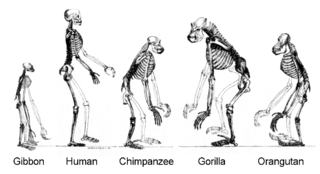
Human evolution is the evolutionary process within the history of primates that led to the emergence of Homo sapiens as a distinct species of the hominid family, which includes all the great apes. This process involved the gradual development of traits such as human bipedalism, dexterity and complex language, as well as interbreeding with other hominins, indicating that human evolution was not linear but weblike. The study of the origins of humans, also called anthropogeny, anthropogenesis, or anthropogony, involves several scientific disciplines, including physical and evolutionary anthropology, paleontology, and genetics.
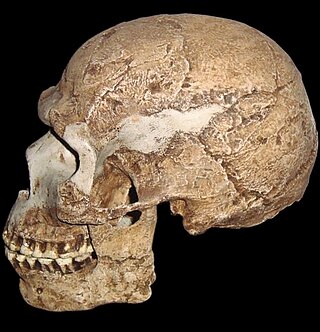
Early modern human (EMH), or anatomically modern human (AMH), are terms used to distinguish Homo sapiens that are anatomically consistent with the range of phenotypes seen in contemporary humans, from extinct archaic human species. This distinction is useful especially for times and regions where anatomically modern and archaic humans co-existed, for example, in Paleolithic Europe. Among the oldest known remains of Homo sapiens are those found at the Omo-Kibish I archaeological site in south-western Ethiopia, dating to about 233,000 to 196,000 years ago, the Florisbad site in South Africa, dating to about 259,000 years ago, and the Jebel Irhoud site in Morocco, dated about 315,000 years ago.

Cro-Magnon is an Aurignacian site, located in a rock shelter at Les Eyzies, a hamlet in the commune of Les Eyzies-de-Tayac-Sireuil, Dordogne, southwestern France.

The Clan of the Cave Bear is a 1980 novel and epic work of prehistoric fiction by Jean M. Auel about prehistoric times. It is the first book in the Earth's Children book series, which speculates on the possibilities of interactions between Neanderthal and modern Cro-Magnon humans.
Earth's Children is a series of epic historical fiction novels written by Jean M. Auel set circa 30,000 years before the present day. There are six novels in the series. Although Auel had previously mentioned in interviews that there would be a seventh novel, publicity announcements for the sixth confirmed it would be the final book in the sequence.
Charles Loring Brace IV was an American anthropologist, Professor Emeritus at the University of Michigan's Department of Anthropology and Curator Emeritus at the University's Museum of Anthropological Archaeology. He considered the attempt "to introduce a Darwinian outlook into biological anthropology" to be his greatest contribution to the field of anthropology.

Lagar Velho is a rock shelter in the Lapedo valley, a limestone canyon 13 km from the centre of Leiria, in the municipality of Leiria, in central Portugal. The site is known for the discovery of a 24,000-year-old Cro-Magnon child, later referred to as the Lapedo child.
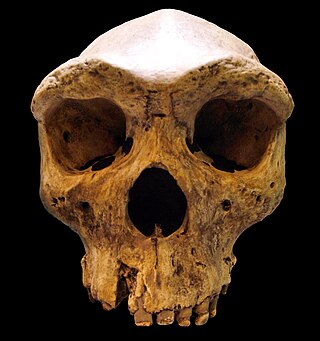
A number of varieties of Homo are grouped into the broad category of archaic humans in the period that precedes and is contemporary to the emergence of the earliest early modern humans around 300 ka. Among the earliest remains of H. sapiens are those from Jebel Irhoud in Morocco, Florisbad in South Africa (259 ka), and Omo-Kibish I in southern Ethiopia. The term typically includes H. antecessor, H. bodoensis, Denisovans (H. denisova), H. heidelbergensis (600–200 ka), Neanderthals, and H. rhodesiensis (300–125 ka).
Richard G. Klein is a Professor of Biology and Anthropology at Stanford University. He is the Anne T. and Robert M. Bass Professor in the School of Humanities and Sciences. He earned his PhD at the University of Chicago in 1966, and was elected to the National Academy of Sciences in April 2003. His research interests include paleoanthropology, Africa and Europe. His primary thesis is that modern humans evolved in East Africa, perhaps 100,000 years ago and, starting 50,000 years ago, began spreading throughout the non-African world, replacing archaic human populations over time. He is a critic of the idea that behavioral modernity arose gradually over the course of tens of thousands, hundreds of thousands of years or millions of years, instead supporting the view that modern behavior arose suddenly in the transition from the Middle Stone Age to the Later Stone Age around 50-40,000 years ago.

Dance of the Tiger is a novel by Finnish palaeontologist Björn Kurtén, published in 1978 and English translation in 1980. It is a prehistoric novel dealing with the interaction between Neanderthals and Cro-Magnons. A sequel, Singletusk, published in 1982, continues the story of the family.

Early human migrations are the earliest migrations and expansions of archaic and modern humans across continents. They are believed to have begun approximately 2 million years ago with the early expansions out of Africa by Homo erectus. This initial migration was followed by other archaic humans including H. heidelbergensis, which lived around 500,000 years ago and was the likely ancestor of Denisovans and Neanderthals as well as modern humans. Early hominids had likely crossed land bridges that have now sunk.
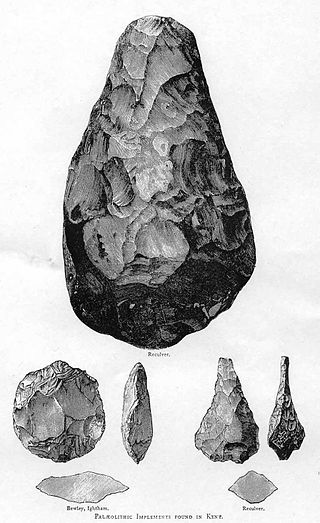
The oldest undisputed examples of figurative art are known from Europe and from Sulawesi, Indonesia, dated about 35,000 years old . Together with religion and other cultural universals of contemporary human societies, the emergence of figurative art is a necessary attribute of full behavioral modernity.
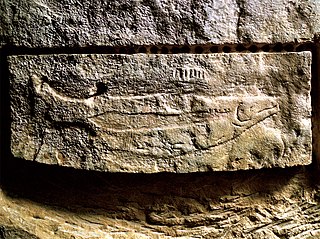
The Prehistoric Sites and Decorated Caves of the Vézère Valley is a UNESCO World Heritage Site in France since 1979. It specifically lists 15 prehistoric sites in the Vézère valley in the Dordogne department, mostly in and around Les Eyzies-de-Tayac-Sireuil, which has been called the "Capital of Prehistory". This valley is exceptionally rich in prehistoric sites, with more than 150 known sites including 25 decorated caves, and has played an essential role in the study of the Paleolithic era and its art. Three of the sites are the namesakes for prehistoric periods; the Micoquien, Mousterian, and Magdalenian. Furthermore, the Cro-Magnon rock shelter gave its name to the Cro-Magnon, the generic name for the European early modern humans. Many of the sites were discovered or first recognised as significant and scientifically explored by the archaeologists Henri Breuil and Denis Peyrony in the early twentieth century, while Lascaux, which has the most exceptional rock art of these, was discovered in 1940.

Grimaldi man is the name formerly given to two human skeletons of the Upper Paleolithic discovered in Italy in 1901. The remains are now recognized as representing two individuals, and are dated to ca. 26,000 to 22,000 years ago and classified as part of the wider Early European modern humans population of the late Aurignacian to early Gravettian.

Cro-Magnons or European early modern humans (EEMH) were the first early modern humans to settle in Europe, migrating from western Asia, continuously occupying the continent possibly from as early as 56,800 years ago. They interacted and interbred with the indigenous Neanderthals of Europe and Western Asia, who went extinct 40,000 to 35,000 years ago. The first wave of modern humans in Europe left no genetic legacy to modern Europeans; however, from 37,000 years ago a second wave succeeded in forming a single founder population, from which all subsequent Cro-Magnons descended and which contributes ancestry to present-day Europeans. Cro-Magnons produced Upper Palaeolithic cultures, the first major one being the Aurignacian, which was succeeded by the Gravettian by 30,000 years ago. The Gravettian split into the Epi-Gravettian in the east and Solutrean in the west, due to major climatic degradation during the Last Glacial Maximum (LGM), peaking 21,000 years ago. As Europe warmed, the Solutrean evolved into the Magdalenian by 20,000 years ago, and these peoples recolonised Europe. The Magdalenian and Epi-Gravettian gave way to Mesolithic cultures as big game animals were dying out and the Last Glacial Period drew to a close.
The multiregional hypothesis, multiregional evolution (MRE), or polycentric hypothesis, is a scientific model that provides an alternative explanation to the more widely accepted "Out of Africa" model of monogenesis for the pattern of human evolution.
Hominid dispersals in Europe refers to the colonisation of the European continent by various species of hominid, including hominins and archaic and modern humans.
The Anne and Bernard Spitzer Hall of Human Origins is an exhibit at the American Museum of Natural History in New York City. It focuses on human evolution, paleoanthropology, archaeology and genetics. At the time of its opening in 1921, it was the first museum exhibit to discuss the controversial topic of evolution. Among its many highlights include the Dordogne cave paintings and the skeleton of Lucy.

Chancelade man is an ancient anatomically modern human fossil of a male found in Chancelade in France in 1888. The skeleton was that of a rather short man, who stood a mere 1.55 m (5.1 ft) tall.

Ape to Man is a dramatised documentary on the scientific community's journey to find the missing link in human evolution, between our ancestors the apes and modern man today.













